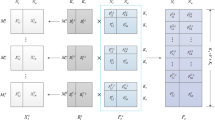Abstract
Often, a data object described by many features can be naturally decomposed into multiple “views”, where each view consists of a subset of features. For example, a video clip may have a video view and an audio view. Given a set of training data objects with multiple views, where some objects are labeled and the others are not, semi-supervised learning with graphs from multi-views tries to learn a classifier by treating each view as a similarity graph on all objects, where edges are defined by the similarity on object pairs based on the view attributes. Labels and label relevance ranking scores of labeled objects can be propagated from labeled objects to unlabeled objects on the similarity graphs so that similar objects receive similar labels. The state-of-the-art, one-combo-fits-all methods linearly and independently combine either the metrics or the label propagation results from multi-views and then build a model based on the combined results. However, the similarities between various objects may be manifested differently by different views. In such situations, the one-combo-fits-all methods may not perform well. To tackle the problem, we develop an iterative Semi-Supervised Metric Fusion (SSMF) approach in this paper. SSMF fuses metrics and label propagation results from multi-views iteratively until the fused metric and label propagation results converge simultaneously. Views are weighted dynamically during the fusion process so that the adversary effect of irrelevant views, identified at each iteration of fusion process, can be reduced effectively. To evaluate the effectiveness of SSMF, we apply it on multi-view based and content based image retrieval and multi-view based multi-label image classification on real world data set, which demonstrates that our method outperforms the state-of-the-art methods.
Access this chapter
Tax calculation will be finalised at checkout
Purchases are for personal use only
Preview
Unable to display preview. Download preview PDF.
Similar content being viewed by others
References
Duygulu, P., Barnard, K., de Freitas, J.F.G., Forsyth, D.: Object recognition as machine translation: Learning a lexicon for a fixed image vocabulary. In: Heyden, A., Sparr, G., Nielsen, M., Johansen, P. (eds.) ECCV 2002, Part IV. LNCS, vol. 2353, pp. 97–112. Springer, Heidelberg (2002)
Huang, Y., Liu, Q., Zhang, S., Metaxas, D.N.: Image retrieval via probabilistic hypergraph ranking. In: CVPR (2010)
Tong, H., He, J., Li, M., Zhang, C., Ma, W.: Graph based multi-modality learning. In: ACM MM (2005)
Wang, B., Jiang, J., Wang, W., Zhou, Z., Tu, Z.: Unsupervised metric fusion by cross diffusion. In: CVPR (2012)
Wang, M., Hua, X., Hong, R., Tang, J., Qi, G., Song, Y.: Unified video annotation via multigraph learning. IEEE Trans. Circuits Syst. Video Techn. 19(5), 733–746 (2009)
Wang, Y., Cheema, M.A., Lin, X., Zhang, Q.: Multi-manifold ranking: Using multiple features for better image retrieval. In: Pei, J., Tseng, V.S., Cao, L., Motoda, H., Xu, G. (eds.) PAKDD 2013, Part II. LNCS, vol. 7819, pp. 449–460. Springer, Heidelberg (2013)
Wang, Y., Lin, X., Zhang, Q.: Towards metric fusion on multi-view data: A cross-view based graph random walk approach. In: ACM CIKM (2013)
Zhou, D., Bousquet, O., Lal, T.N., Weston, J., Schlkopf, B.: Learning with Local and Global Consistency. In: NIPS (2003)
Zhou, D., Weston, J., Gretton, A., Bousquet, O., Schlkopf, B.: Ranking on data manifolds. In: NIPS (2003)
Zhu, X.: Semi-supervised learning with graphs. PhD thesis, Carnegie Mellon University (2005)
Author information
Authors and Affiliations
Editor information
Editors and Affiliations
Rights and permissions
Copyright information
© 2014 Springer International Publishing Switzerland
About this paper
Cite this paper
Wang, Y., Pei, J., Lin, X., Zhang, Q., Zhang, W. (2014). An Iterative Fusion Approach to Graph-Based Semi-Supervised Learning from Multiple Views. In: Tseng, V.S., Ho, T.B., Zhou, ZH., Chen, A.L.P., Kao, HY. (eds) Advances in Knowledge Discovery and Data Mining. PAKDD 2014. Lecture Notes in Computer Science(), vol 8444. Springer, Cham. https://doi.org/10.1007/978-3-319-06605-9_14
Download citation
DOI: https://doi.org/10.1007/978-3-319-06605-9_14
Publisher Name: Springer, Cham
Print ISBN: 978-3-319-06604-2
Online ISBN: 978-3-319-06605-9
eBook Packages: Computer ScienceComputer Science (R0)




